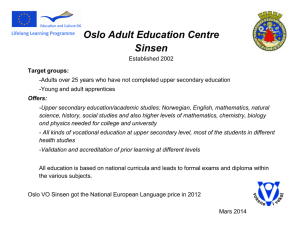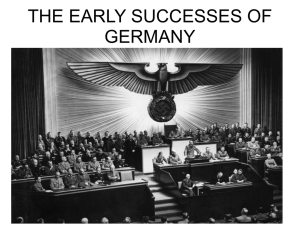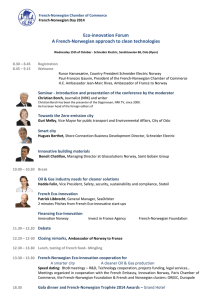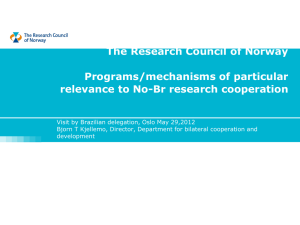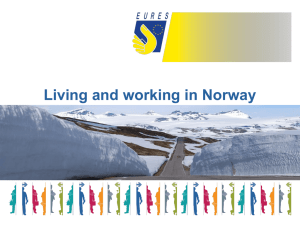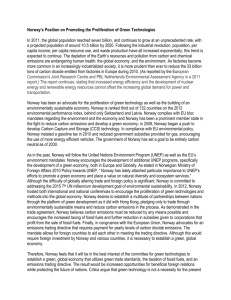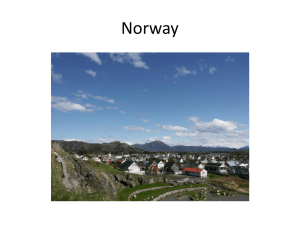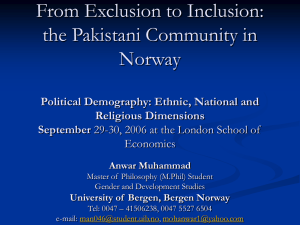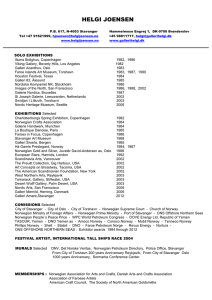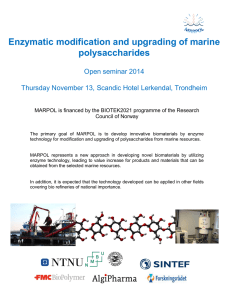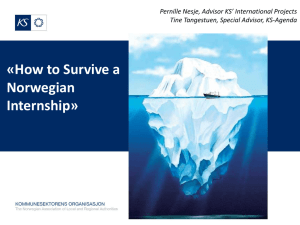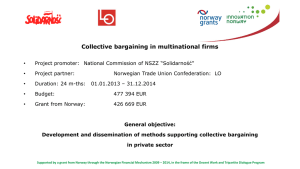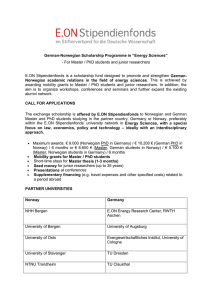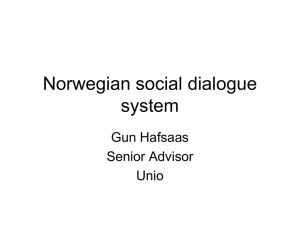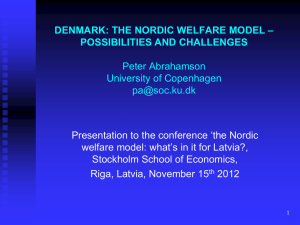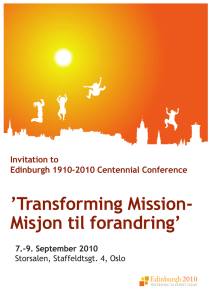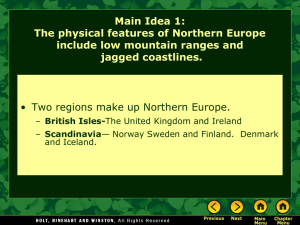Norway - itslearning
advertisement
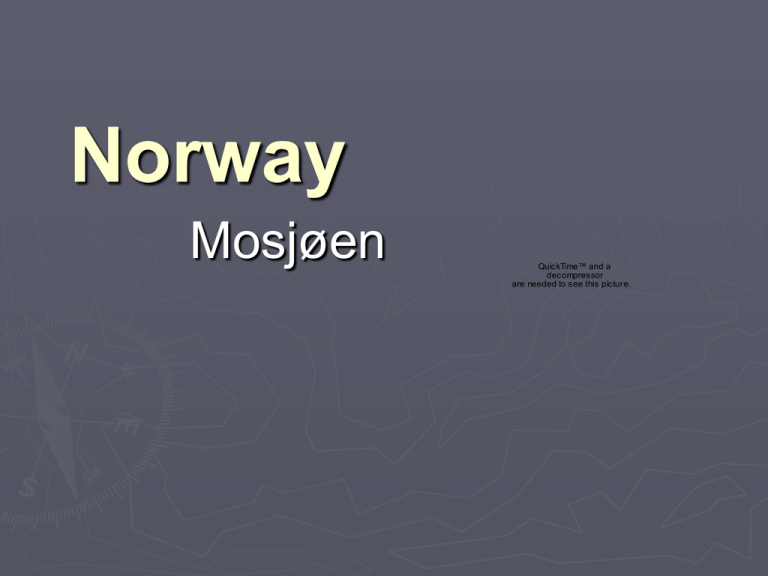
Norway Mosjøen QuickTime™ and a decompressor are needed to see this picture. Historical facts: 1350: the Black plague, "Svartedauen" sweeps Denmark and Scandinavia killing one third of the inhabitants 1397 - Union of Kalmar unites Denmark, Sweden and Norway under a single monarch. Denmark is the dominant power 1536 Danish becomes the written language of Norway 1814 The Norwegian constitution was written 1814 The peace treaty of Kiel and Denmark cedes Norway to Sweden 1905 The union with Sweden disintegrates and Norway becomes an independent kingdom 1905 The Danish prince Karl becomes King Haakon VII of Norway 1914-18 World War I and Norway remains neutral 1940 9th of April Germany occupies Norway 1945 8th of May Germany surrenders to the Allies and the Nazioccupation ends in Norway 1945- today: Indipendence - Social Democracy and the OIL The Welfare State The founding of Norway King Harald Fairhair is the king who is credited by later tradition as having unified Norway into one kingdom. According to the sagas, he ruled Norway from approximately 872 to 930. QuickTime™ and a decompressor are needed to see this picture. 1814 - The Norwegian constitution The Norwegian constitution was inspired by the United States Declaration of Independence in 1776 and the French revolution in 1789 and the subsequent U.S. and French constitutions. QuickTime™ and a decompressor are needed to see this picture. War and Occupation (1940 - 1945) When the Germans invaded in 1940 they demanded an end to all opposition, and acceptance of a german occupation. These demands were refused by the King and the government. The fighting in southern Norway lasted three weeks, but the struggle continued in the Narvik area until the 7th of June. Then the government and the royal family crossed to London to carry on the war. In Norway the Germans set about reorganising the country along Nazi lines with the help of Vidkun Quisling and NS. But this was thwarted by the people in the worlds of sport, the Church, education and various trades and professions who combined into a bro adly-based resistance movement. Towards the end of the war the resistance leadership cooperated closely with the government in exile in London to form a clandestine army, Milorg. In May 1945 the Germans laid down their arms, and on 7 June the King and the government returned to a liberated Norway. Teachers’ resistance during the war -Invation of Norway April 1940 -Norway was an important piece in international politics -Massive resistance -Teachers were not persuaded or defeated Some facts During Autumn -40 and Spring of -41, there was made attempt from the enemy to break teacher’s resistance Norway had 14 000 teachers and 12 000 of them protested openly. Severe consequences. Some were summoned to labour duty at German military plants March -42 1100 teachers were arrested and they got a harsh treatment both physically and mentally The NS threatened teachers with dismissal. This would mean that schools would be close. Why control teachers? 1 The teachers’ organisation had for many years been voluntary and nationwide. By ”conquering” the organisation they would reach out to a large area. 2 Important for the nazis to spread their ideology and get it implemented by the Norwegian population. This ment that schools taught after the basic ideas of this ideology – far away from our own. http://fuv.hivolda.no/prosjekt/taksean/htm Norwegian school history When? For whom? What/purpose? DA KLOKKA KLANG Tekst: Margrethe Munthe Da klokken klang, så fort vi sprang, og ingen sto igjen og hang, men glad og lett og rank og rett vi var på plass med ett. Vi sto som perler på en snor, og ingen av oss sa et ord, og ingen lo, men stille sto vi sammen, to og to. When? Norway is a part of Denmark Christian VI rules and he was a pietist He wants everyone to learn about the words of God in 1736 confirmation for everyone. To get a job or get married you had to be confirmated A result of this -children could attend school from the age of 7 in1739 The upper class already had private tutors/schools or went to latin schools. A good intention? The Periodical schooling was the solution - One of the 1st countries that got a public schools - pesentsresistance Lost labour Had to pay Period with diseases Learning at home Learning in church Goal: one school for everyone independent of their status and wealth Examle of a periodical school 3 months a year Purpose Learning about christianity CHANGES 1800 – new society 1827 – school buildings not on farms anymore 1860 – fewer schools on farms, encyclopedic reading books, the bond between schools and the church becomes weaker 1889 - - New law Demands to the schools and to teaching material Longer hours History, science and geography becomes compulsory, books are made for each subject Teachers got a higher status 1915: Free teaching material 1950-1960 CHANGE - - Demands to how the buildings should be Better education 1969 – everyone has the rigth to 9 years at school Nowadays New governments – new school reforms 10 years of compulsory school We discuss a school for everyone or for the elite? What about room for private schools? Norwegian students enjoy school say surveys, the social part of it, but do they learn proportionally with their feeling of comfort? Sources http://www.aktivioslo.no/barnesmunthe.ph p#klokka http://www.bindalseidet.net/historie.htm http://www.multinet.no/~paalk/facts.html


